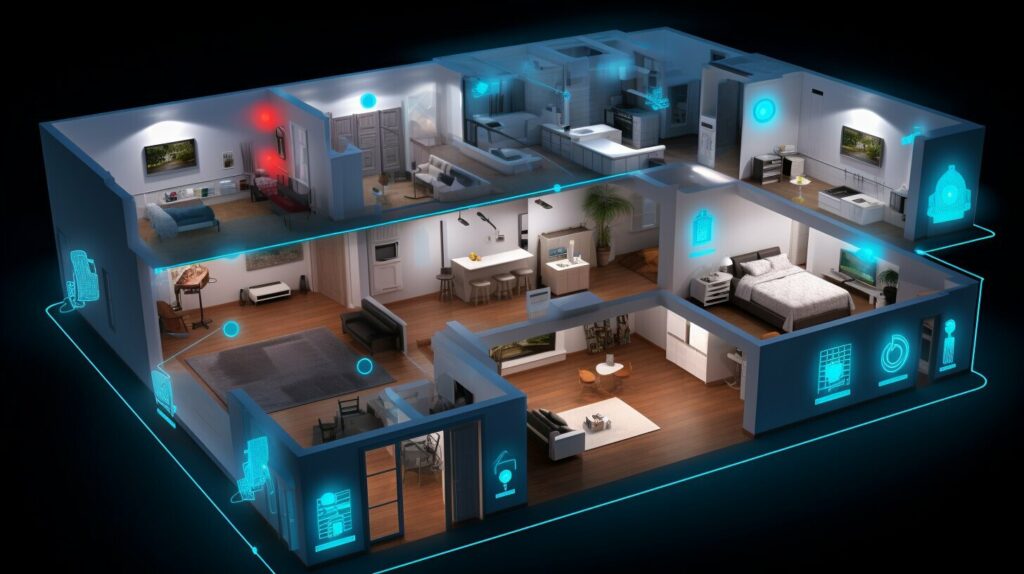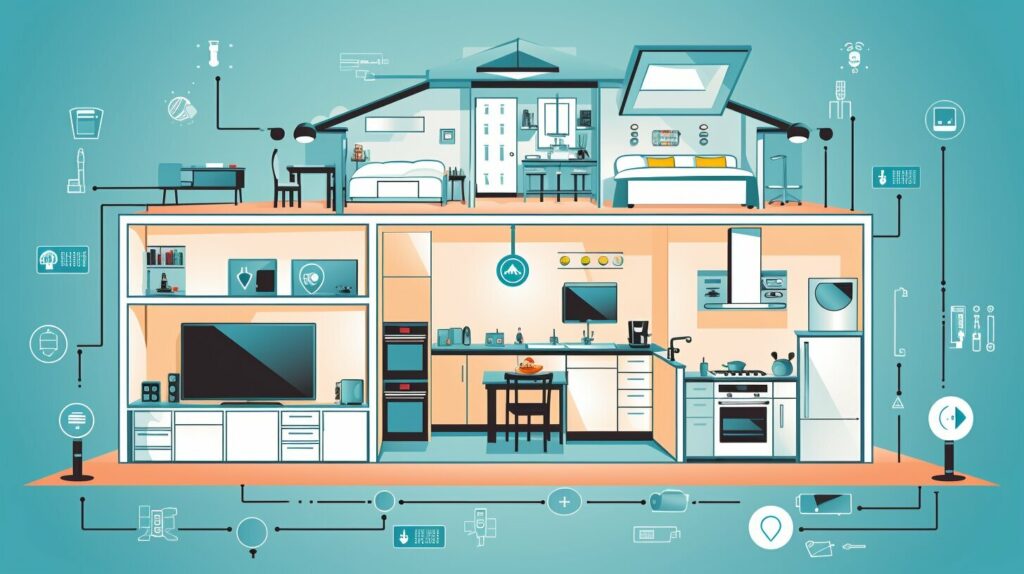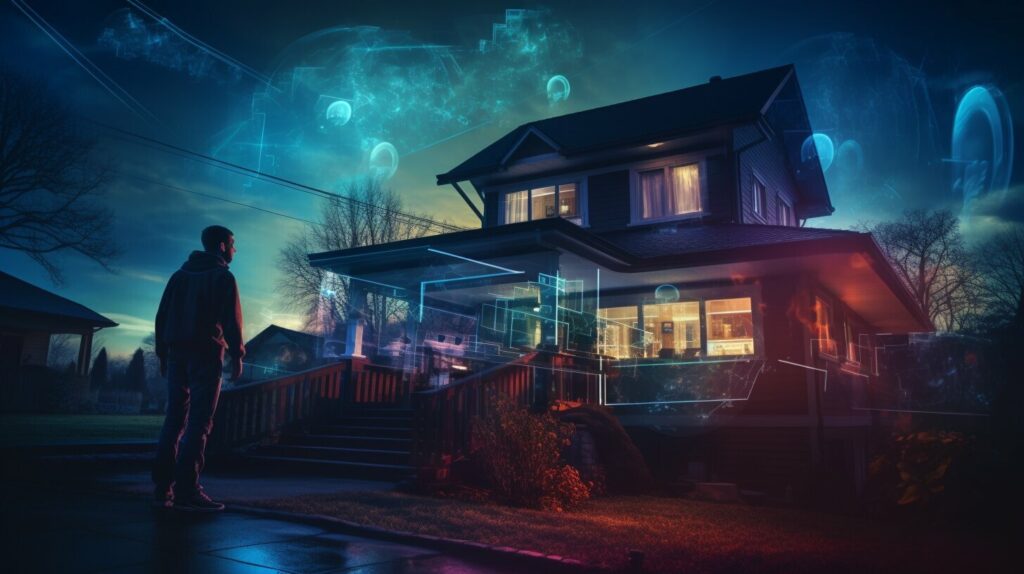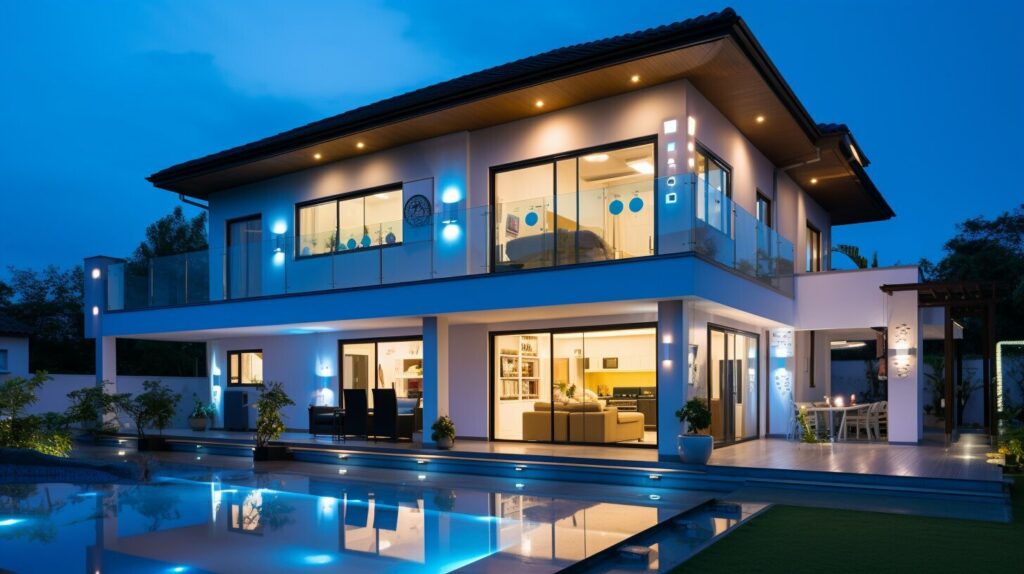Home automation has become increasingly popular in recent years, with homeowners looking for ways to make their homes more comfortable and convenient. A smart home system can help automate various tasks, making everyday life easier and more efficient. Arduino, a microcontroller platform that allows for complex programming and automation, can be used to build a smart home system with WiFi connectivity.
By using Arduino as a platform, you can integrate various sensors and actuators to monitor and control different aspects of the home, such as lighting, temperature, and security. With some basic programming knowledge and a few essential components, you can create a custom smart home solution that meets your specific needs.
Key Takeaways:
- Building a smart home system with Arduino and WiFi can provide a more convenient and efficient way to automate tasks in your home.
- Arduino is a versatile platform that can be used to build custom smart home solutions.
- With some basic programming knowledge and essential components, you can create a smart home system that meets your specific needs.
Getting Started with Arduino for Home Automation
Arduino is a versatile platform that can be used to create a variety of DIY smart home projects. If you’re interested in building your own smart home system, Arduino may be the perfect place to start. With the right components and programming, you can use Arduino to automate and control a wide range of devices and systems in your home.
To get started with Arduino for home automation, you’ll need a few basic components:
| Component | Description |
|---|---|
| Arduino board | The central component that powers your smart home system. |
| Sensors and actuators | Devices that measure and control various aspects of your home, such as temperature, humidity, lighting, and security. |
| WiFi module | Allows your Arduino board to connect to your home network and the internet. |
| Breadboard and jumper wires | Used to connect the various components together without soldering. |
Once you have these components, you’re ready to start building your smart home system. There are many online resources available that provide step-by-step tutorials and projects for Arduino-based home automation. You can explore these resources to find projects that interest you and that match your skill level.
One of the most popular Arduino smart home projects is creating a smart thermostat. With a few different sensors, you can monitor temperature and humidity levels in your home and adjust your heating and cooling system accordingly. This can save you money on your energy bill and make your home more comfortable.
Another popular project is creating an Arduino-based security system. By connecting motion sensors, cameras, and alarms to your Arduino board, you can monitor your home for intruders and receive alerts if there is any unusual activity.
Whether you’re a beginner or an experienced DIY enthusiast, there is an Arduino-based home automation project that you can tackle. With the right tools and resources, you can create a custom smart home system that perfectly meets your needs and preferences.
Setting up WiFi Connectivity with Arduino
In order to create a smart home system with Arduino, it is essential to set up WiFi connectivity. This will allow the Arduino-based devices to communicate with each other and with the internet, enabling remote access and control.
There are several components required for setting up WiFi connectivity with Arduino, including:
- Arduino board with WiFi capabilities
- WiFi module or shield
- Router with internet connectivity
To connect Arduino to WiFi, you can use either the built-in WiFi capabilities of some Arduino boards or add a WiFi module or shield to the board. The module or shield connects to the router and acts as a bridge between the Arduino board and the network.
It is important to ensure a stable connection for smart home automation, as connectivity issues can lead to malfunctions and security vulnerabilities. To maintain a stable connection, ensure that the WiFi signal is strong and stable, and use secure passwords and encryption protocols.
Once the WiFi connectivity is established, you can begin building and programming smart home devices with Arduino. In the next section, we will explore how to create smart home devices using Arduino.
Creating Smart Home Devices with Arduino
Arduino is a versatile platform that can be used to build a wide range of smart home devices. By using different sensors and actuators, you can create devices that monitor and control various aspects of your home.
One popular smart home device that can be created with Arduino is a smart thermostat. With the help of a temperature sensor, you can program your Arduino to adjust your thermostat to maintain a comfortable temperature in your home. This not only saves energy, but also provides you with a comfortable living space.
Another smart home device that can be created with Arduino is a smart lighting system. By using a motion sensor, you can program your Arduino to turn on and off the lights in your home based on your movement. This not only saves energy, but also adds a level of convenience to your home.
| Arduino Component | Description |
|---|---|
| Temperature Sensor | Measures temperature in a given area |
| Motion Sensor | Detects movement in a given area |
| Relay Module | Controls power output to various devices in your home |
| LED Strip | Provides ambient lighting and can be controlled using Arduino |
Once you have chosen the sensors and actuators that you want to use, you can program your Arduino to monitor and control them. By using programming languages such as C and C++, you can create automation routines that allow your smart home devices to work seamlessly together.
One of the advantages of using Arduino for your smart home projects is the availability of community-supported libraries. These libraries provide pre-written code for various sensors and actuators, allowing you to get started quickly and easily.
Creating smart home devices with Arduino requires some technical skill and knowledge, but it can be a rewarding experience. The ability to control and monitor your home using custom-built devices provides a level of convenience and control that is hard to beat.
Integrating Sensors and Actuators with Arduino
Sensors and actuators are essential components in creating a smart home system with Arduino. They allow for monitoring and control of home systems, making the automation process more efficient and effective. Integrating sensors and actuators with Arduino is a critical step in creating a fully functional and automated smart home.
When building a smart home system with Arduino, it is essential to choose the right sensors and actuators for the specific needs of the home. A wide range of sensors and actuators is available, including temperature sensors, motion sensors, and smart switches, to name a few. It is crucial to choose sensors and actuators that will provide accurate data and precise control over the home systems.
To integrate sensors and actuators with Arduino, first, identify the pins required for the components. The Arduino board has a set of digital and analog pins that can be used for connecting sensors and actuators. Each component requires a specific pin connection, which can be found in the component’s datasheet. Connect the pins of the components to the corresponding pins on the Arduino board.
Once the components are connected, use the appropriate code and libraries to read the sensor data or control the actuator. For instance, to read data from a temperature sensor, use the OneWire library to communicate with the sensor and retrieve the data. Similarly, to control an actuator such as a smart switch, use the appropriate library to send the commands to the switch.
Sensors and actuators can be used to create a wide range of smart home devices, including automated lighting, climate control systems, and security systems. With the right combination of sensors and actuators and a well-designed automation routine, it is possible to create a truly smart home with Arduino.
Programming Arduino for Home Automation
Programming Arduino for smart home automation provides a versatile platform for creating customised routines to control devices around your home. Whether you intend to optimise your energy usage, increase security, or simply automate everyday tasks, the possibilities are endless. In this section, we will explore the basics of programming Arduino and how you can use it to create automation routines for your smart home.
Programming Languages for Arduino
Arduino-based home automation projects can be programmed using a variety of languages, including C++, Python, Scratch, and Java. The Arduino Integrated Development Environment (IDE) supports all these languages, so you can choose the one that best suits your skills and preferences. If you’re new to programming, we recommend starting with C++, as it is the most widely used language for Arduino projects.
Libraries for Home Automation
Arduino libraries are pre-written code for a specific task that can be used in your sketch. Libraries can save you time by providing pre-made code for complex tasks such as controlling sensors or actuators. There are numerous libraries available for different home automation projects, such as controlling lighting, temperature, and security systems. Some popular ones include:
| Library Name | Description |
|---|---|
| Adafruit IO | Allows you to send and receive data with Adafruit IO, a cloud service for IoT devices |
| PubSubClient | Enables MQTT communication between Arduino and other devices over a network |
| DHT Sensor Library | Allows you to read temperature and humidity data from DHT sensors |
Using libraries is a great way to save time and streamline your programming process. You can easily add or remove libraries from your Arduino IDE to simplify your code and avoid redundancies.
Creating Automation Routines
Once you have set up your Arduino with the necessary hardware and software, creating automation routines is easy. The first step is to identify the devices you want to control and the actions you want them to perform. You can then write the necessary code to trigger these actions at specific times or events.
For example, you could create an automation routine to turn off all lights in your home at a specific time each night. Or you could create a routine that turns on the light and adjusts the temperature when someone enters a room.
Debugging Your Code
Debugging is an essential part of programming Arduino for home automation. Even the smallest mistake can prevent your system from functioning optimally. Common errors include incorrect wiring or coding syntax errors.
Always test your code thoroughly to ensure it works as expected. Use serial output to debug any issues and print relevant information to help you identify and correct errors. You can also use the serial monitor to track sensor readings and other data to ensure your system is operating as intended.
By programming Arduino for home automation, you can create customised routines to control and monitor your devices. With the right programming languages and libraries, the possibilities are endless. Always test your code thoroughly and use debugging tools to correct any errors.
Building a Central Control System with Arduino
Once you have set up your smart home devices and sensors, it is time to create a central control system that allows you to manage them all in one place. This is where the power of Arduino really shines.
The first step in building a central control system with Arduino is to select the right components. You will need an Arduino board, WiFi module, and a display module. You can also add other components such as buttons, switches, and LEDs to create a more user-friendly interface.
The next step is to program the Arduino board to control the various devices in your smart home. You can use a programming language like C++ or Python, or a graphical programming tool like Scratch. The key is to write clear, concise code that is easy to understand and modify.
Once your Arduino board is set up and programmed, you can create your user interface. This can be as simple as a basic display that shows the status of each device, or as complex as a touchscreen interface with multiple menus and options.
One of the great things about building a central control system with Arduino is that it is highly customizable. You can add new devices and sensors as needed, or modify the programming to create new automation routines. This gives you full control over your smart home and allows you to customize it to suit your needs.
Overall, building a central control system with Arduino is a great way to take your smart home to the next level. It gives you full control over your devices and allows you to create a user-friendly interface that is easy to use and modify. With the right components and programming, you can create a smart home that is truly customized to your needs and preferences.
Security and Privacy Considerations for Arduino-based Smart Homes
When it comes to smart home systems using Arduino smart home automation or Arduino based home automation, security and privacy are crucial considerations. With the variety of devices and sensors connected to the system, it is essential to ensure the system is protected from external threats and user data remains secure.
One of the first steps in securing your smart home system is to change the default passwords for both the system and any connected devices. This prevents unauthorized access from outsiders who may have access to default username and password information.
Another essential security measure is to keep the software and firmware up-to-date. Regular updates can patch any vulnerabilities that may have been discovered and reduce the risk of intrusion or hacking.
It’s also crucial to use encryption protocols for data transmission. This prevents sensitive data from being intercepted by malicious users. Additionally, it is advisable to separate the smart home network from the primary WIFI network to prevent unauthorized access to other devices on the network.
Moreover, consider the privacy implications of using smart home devices. Such devices collect a significant amount of data, and it is essential to know how this data is being stored and used. Read through the privacy policies for each device connected to the smart home system to ensure that your data is safe and not being used inappropriately.
Lastly, be aware of the risk of physical tampering. Any device connected to the smart home system can be a potential entry point for an attacker. Ensure that all devices are physically secured and monitored, and consider installing security cameras to keep a watchful eye on your property.
Protecting your smart home system and data is a critical aspect of creating a secure and reliable home automation system. By implementing the above tips and best practices, you can ensure that your Arduino smart home ideas are realized in a safe and secure manner.
Troubleshooting Common Issues in Arduino-based Smart Homes
While building a smart home system with Arduino can be a rewarding experience, it’s not without its challenges. Here are some common issues that may arise when setting up Arduino-based home automation and how to troubleshoot them.
Connectivity Issues
One common issue when building a smart home system with Arduino is connectivity. If your smart home devices fail to connect to WiFi, try moving them closer to the WiFi router. Walls or other obstacles can interfere with WiFi signals, so make sure your devices have a clear path to the router.
Another solution is to use a WiFi extender to boost the signal strength. Additionally, double-check that you have entered the correct WiFi credentials when configuring your Arduino devices.
Programming Issues
If your smart home devices are not functioning as intended, the programming may be the culprit. Make sure you have uploaded the correct code to your Arduino board and that all components in your circuit are wired correctly.
You may also need to adjust the code to ensure that it works with all the components in your circuit. Troubleshooting Arduino programming issues can be time-consuming, but taking the time to debug your code is well worth it in the end.
Hardware Issues
Sometimes, hardware issues can cause problems with your smart home devices. If your devices are not working as intended, check to ensure that all the hardware components are properly connected. Loose connections or faulty components can cause your devices to malfunction, so double-check everything.
You may also need to replace malfunctioning components to get your devices back up and running. If you’re not sure which component is causing the issue, try testing each component individually to find the problem.
By troubleshooting these common issues, you can get your Arduino-based smart home system up and running smoothly. With a little patience and persistence, you’ll be able to enjoy the benefits of home automation in no time.
Conclusion
In conclusion, building a smart home system with Arduino and WiFi offers numerous benefits. With home automation becoming increasingly popular, Arduino provides an affordable platform for creating smart home devices and systems. By following the steps outlined in this article, homeowners can leverage the power of Arduino to create customized and user-friendly smart home automation.
In this article, we discussed various components needed to set up an Arduino-based smart home. We explained how to configure WiFi connectivity with Arduino and how to build and program smart home devices using Arduino. We also discussed the integration of sensors and actuators and the importance of programming for home automation. Additionally, we provided tips for building a central control system and addressed security and privacy considerations.
With proper planning and troubleshooting, homeowners can create a reliable and efficient smart home system with Arduino. By using the SEO relevant keywords – Smart Home System with Arduino, Arduino smart home automation, Arduino based home automation, we hope this article provided valuable insights into building a smart home system with Arduino and WiFi for those considering home automation.





